I. What are Antagonistic Endocrine Hormone Pairs?
You might see this article titled and be a little confused with its name. Probably when studying hormones in other books or resources, they may have been categorized based on the organ it originates from, the type of hormone, etc. However, we here at MCAT Mastery have categorized the hormones this way as a strategic way to aid in your MCAT!
Antagonistic endocrine hormone pairs refer to pairs of hormones whose functions OPPOSE each other. One hormone basically works to counteract the other hormone in terms of the physiological outcome that is supposed to take place.
We HIGHLY encourage you all to employ this “antagonistic/opposing” motif and strategy to your MCAT prep. This is because when studying antagonistic terms, memorizing one term/concept may be sufficient because the other term within the pair just does the OPPOSITE! (i.e. In the antagonistic pair A and B, A causes an INCREASE in X. Therefore, B should cause a DECREASE in X because of the antagonistic relationship.)
II. Content Review
The last paragraph gives a good example of how you should use this strategy when encountering these antagonistic motifs. We’ve identify 3 hormone pairs with antagonizing relationships:
A. Insulin & Glucagon
Both of these hormones are peptide hormones and are released by the Islet of Langerhans cells located within the pancreas: specifically, insulin is released by the 𝛽-cells while glucagon is released by the 𝛼-cells.
Now pay attention to the antagonistic relationship between insulin and glucagon: insulin will work to ↓↓ DECREASE blood glucose levels while glucagon will work to ↑↑ INCREASE blood glucose levels.
Insulin ⇒ Released after consuming a meal, especially one big in carbohydrates
Glucagon ⇒ Released in a state of fasting to send nutrients to the rest of the body
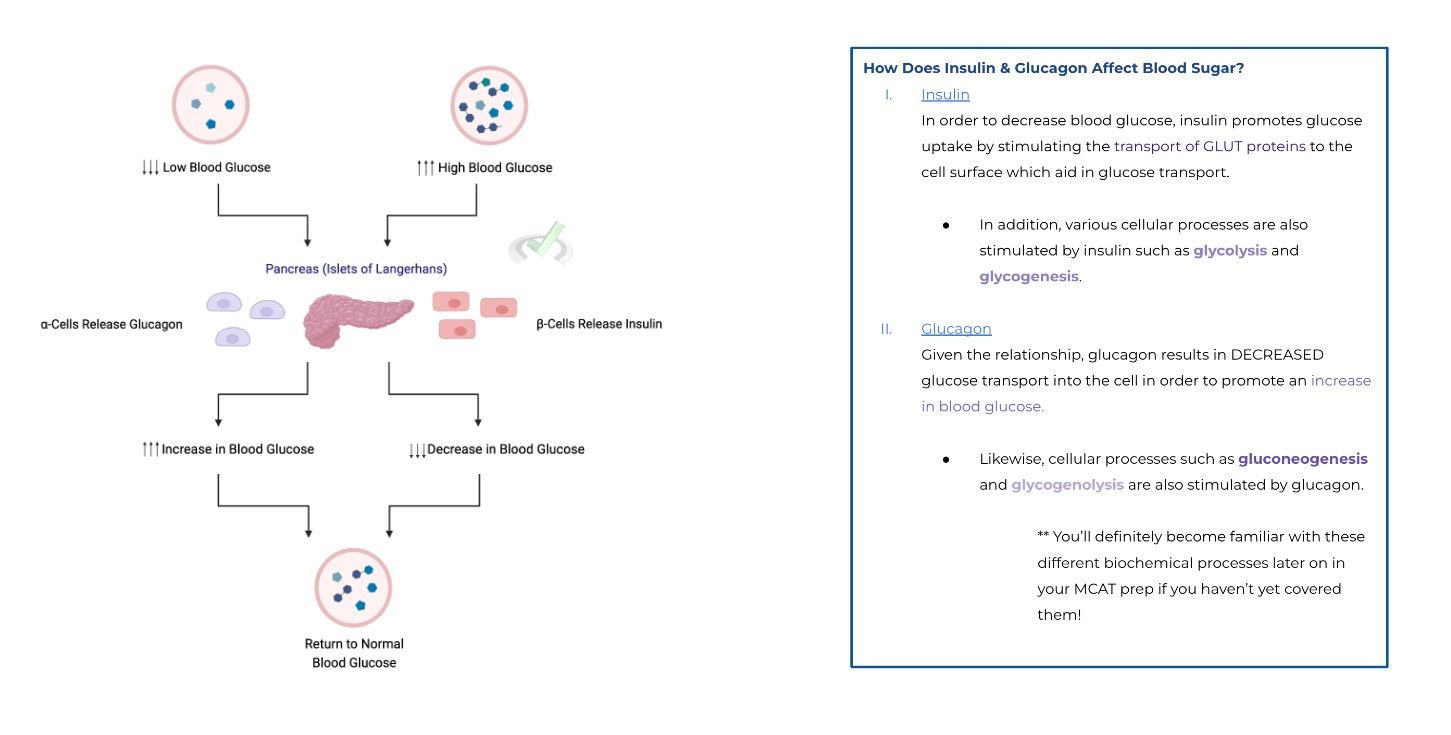
**Note!:
There is also another hormone known as somatostatin which is not listed above. This hormone is released by the 𝛿-cells, also located in the Islet of Langerhans in the pancreas and works to INHIBIT both insulin and glucagon.
- Don’t worry too much about this hormone as this is fairly low yield in MCAT content.
B. Calcitonin & Parathyroid Hormone (PTH)
Similarly, both of these hormones are peptide hormones (again, keep in mind the various properties of the different types of hormones!).
Calcitonin is actually released by the thyroid gland while the parathyroid hormone (surprise, surprise) is released by the parathyroid gland.
Again, the same strategy applies when discussing these hormones: calcitonin will work to ↓↓ DECREASE blood calcium levels while the parathyroid hormone (PTH) will work to ↑↑ INCREASE blood calcium levels..
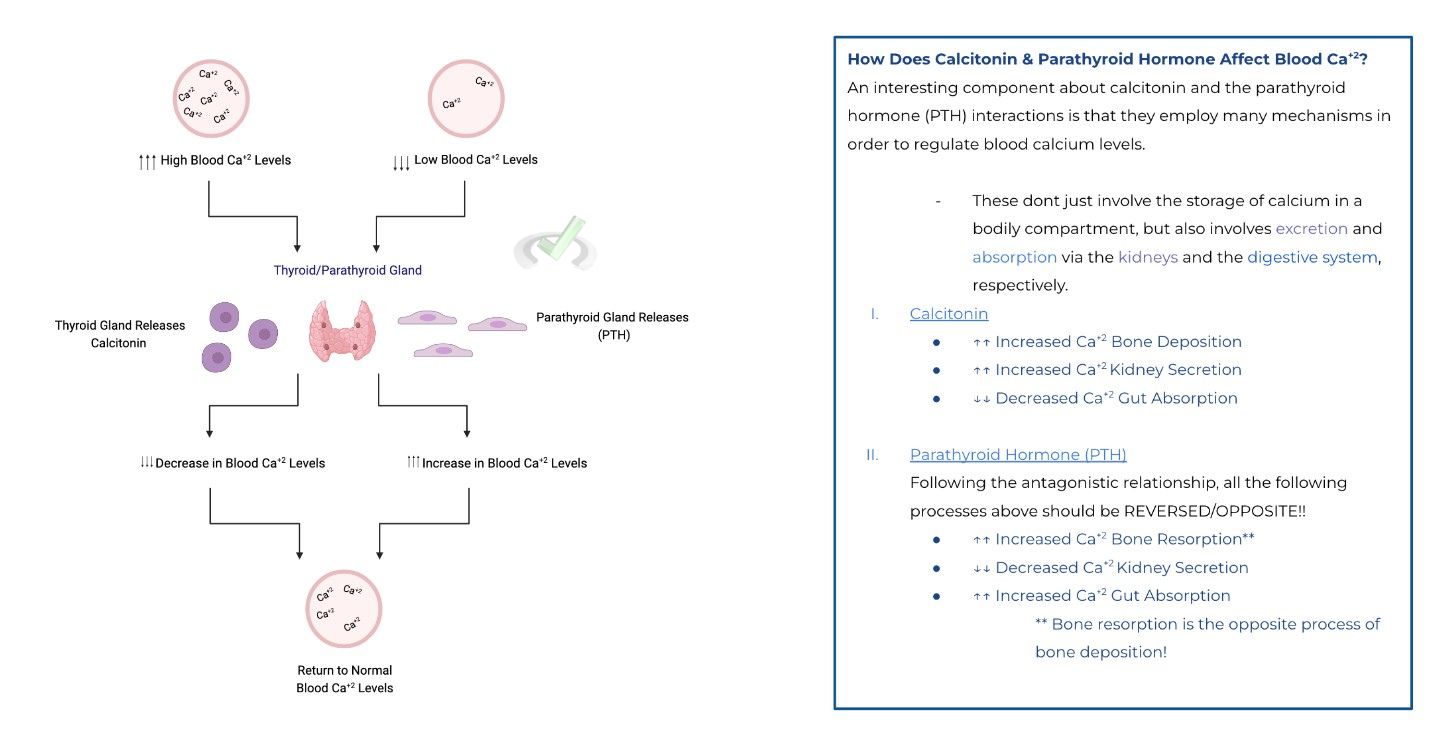
C. Aldosterone & Atrial Natriuretic Peptide (ANP)
These 2 hormones are a little different in the sense that aldosterone is classified as a steroid hormone while the atrial natriuretic peptide is classified as (you guessed it!) a peptide hormone.
Furthermore, they are released in different parts of the body as well → aldosterone is released by the adrenal gland while ANP is released by the atrial cells of the heart.
The main physiological effect that is regulated by the 2 hormones is blood pressure (and blood volume indirectly). Specifically, aldosterone works to INCREASE blood pressure while the atrial natriuretic peptide (ANP) works to DECREASE blood pressure.
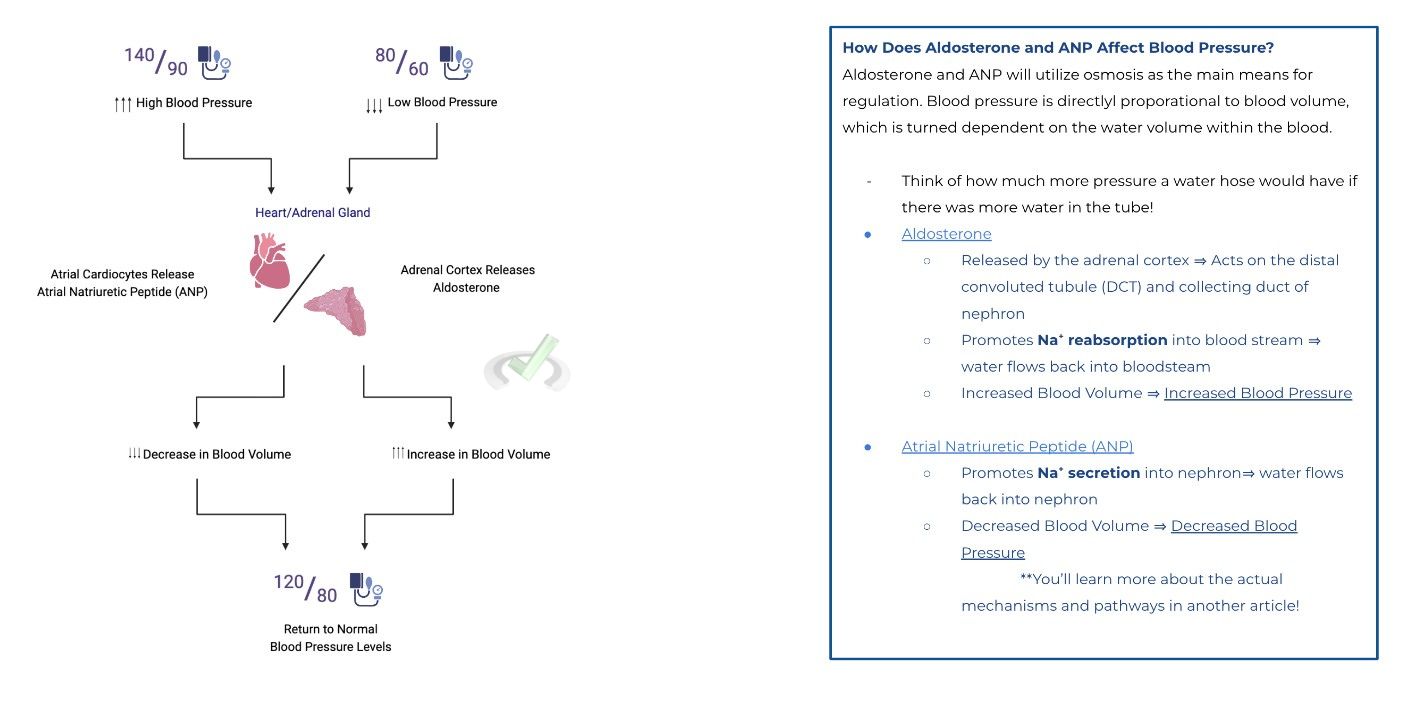
III. Bridge/Overlap
We’ll primarily focus on how insulin and glucagon can affect biochemical processes, as much of the processes they affect we’ll come up in MCAT prep and are significant high yield content!
When looking at how insulin and glucagon causes changes in blood glucose levels, it’s best to do so at the cellular and molecular level! Let’s take a look at how both hormones can affect processes at both levels.
a. Insulin:
As stated above, the release of insulin stimulates the processes of glycolysis and glycogenesis to occur in order to decrease blood glucose levels.
Glycolysis:
Process where glucose is brought into the cell where it will be oxidized into several substrates while also producing high energy intermediates such as ATP.

Glycogenesis:
Process where glucose is brought into the cell and is stored as a repeating polymer of glucose, called glycogen.

How about at the molecular level? Although the transport of glucose into the cells via GLUT receptors is the first step in order to undergo glycolysis and glycogenesis, insulin can also stimulate and activate the main enzymes involved in these processes, including:
b. Glucagon
Likewise, the release of glucagon stimulates the processes which oppose glycolysis and glycogenesis, those being gluconeogenesis and glycogenolysis.
Gluconeogenesis:
Process by which glucose can be synthesized from various molecules including various amino acids and intermediates.

Glycogenolysis:
Process by which glucose is produced and released via the breakdown of glycogen storages within the cell.

Glucagon goes on to regulate these processes at the molecular levels as well! Let’s take a look at some of the main enzymes that are stimulated/activated by glucagon.
IV. Wrap Up/Key Terms
Let’s take this time to wrap up & concisely summarize what we covered above in the article!
Endocrine Hormones: Antagonistic Pairs
Categorizing these sets of hormones this way may be a beneficial study/strategy tool to use because as long as you remember the effects and actions of one hormone in the pair, the complementary hormones will promote the OPPOSITE effects and actions.
There are 3 hormonal pairs that can be characterized as having antagonizing effects:
A. Insulin & Glucagon
Primary Physiological Stimulus: Blood Sugar Levels
Insulin ⇒ ↓↓ DECREASES Blood Glucose
Promotes glucose uptake via transport of GLUT transport proteins to surface
Stimulates processes at a molecular level, promoting processes such as glycolysis & glycogenesis
⇒ Released after the consumption of a meal, especially one high in carbs
Glucagon ⇒ ↑↑ INCREASES Blood Glucose
Promotes DECREASED glucose transport into cells
Also stimulates processes at a molecular level, promoting opposing processes including gluconeogenesis & glycogenolysis
⇒ Released during a state of fasting so as to get the carbohydrate energy source to other parts of the body
B. Calcitonin & Parathyroid Hormone (PTH)
Primary Physiological Stimulus: Blood Ca+2 Levels
Calcitonin ⇒ ↓↓ DECREASES Blood Ca+2
↑↑ Increased Ca+2 Bone Deposition
↑↑ Increased Ca+2 Kidney Secretion
↓↓ Decreased Ca+2 Gut Absorption
Parathyroid Hormone (PTH) ⇒ ↑↑ INCREASES Blood Ca+2
↑↑ Increased Ca+2 Bone Resorption**
↓↓ Decreased Ca+2 Kidney Secretion
↑↑ Increased Ca+2 Gut Absorption
⇒ Note**: Bone resorption is essentially the opposite process of bone deposition!
C. Aldosterone & Atrial Natriuretic Peptide (ANP)
Primary Physiological Stimulus: Blood Pressure
Aldosterone ⇒ ↑↑ INCREASES Blood Pressure
↑↑ Increased Na+ reabsorption into the bloodstream ⇒ H2O also flows via osmosis
Increased Blood Volume (via Increased H2O) ⇒ Increased Blood Pressure
Atrial Natriuretic Peptide (ANP)) ⇒ ↓↓ DECREASES Blood Pressure
↑↑ Increased Na+ secretion into the bloodstream ⇒ H2O also flows via osmosis
Decreased Blood Volume (via decreased H2O) ⇒ Decreased Blood Pressure
V. Practice
Take a look at these practice questions to see and solidify your understanding!
Sample Practice Question 1:
Osteoporosis describes a chronic condition where bones deteriorate and lose bone density. One probable cause is due to the decreased bone mineral density, with calcium being one of the main components – this is particularly the case for postmenopausal osteoporosis. As such, which of the following hormones could be supplemented for treatment of postmenopausal osteoporosis?
A. Insulin
B. Parathyroid Hormone (PTH)
C. Aldosterone
D. Calcitonin
Ans. D
Because this question states that calcium is a major component of the bone, insulin and aldosterone can be eliminated as answer choices as these hormones have no interaction or effect on calcium.
While calcitonin and the parathyroid hormone (PTH) are hormones both involved in calcium regulation, calcitonin supplements should be used because calcium works to DECREASE blood Ca+2 levels.
One method that calcium utilizes is increase bone deposition ⇒ increases the bone mineral density ⇒ Mitigating the effects of postmenopausal osteoporosis.
Sample Practice Question 2:
Ryder eats his dinner at around 8 pm, and goes to bed at around 11 pm. Which of the graphs depicts the proper timed releases of the hormones insulin & glucagon?


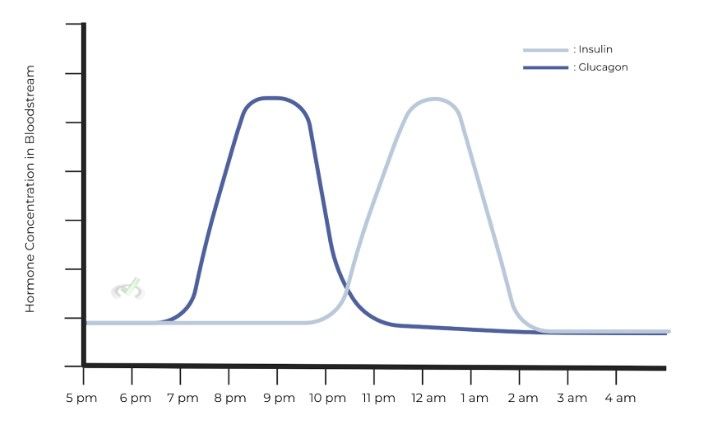
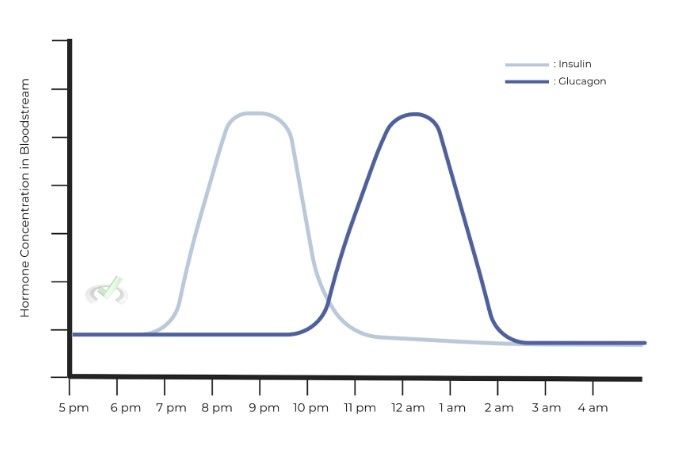
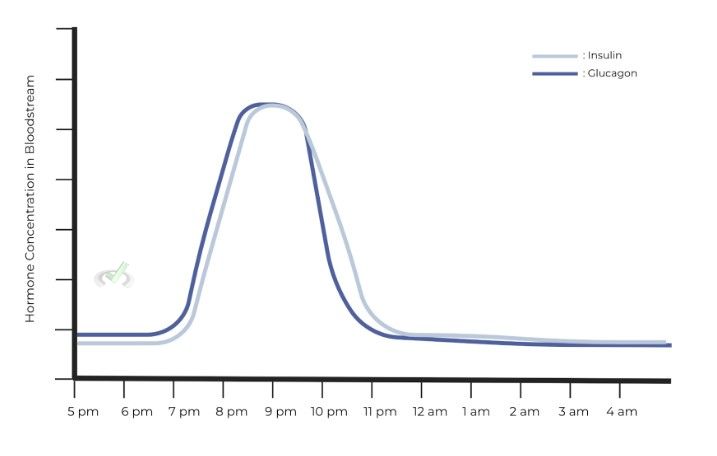


 To help you achieve your goal MCAT score, we take turns hosting these
To help you achieve your goal MCAT score, we take turns hosting these 
























